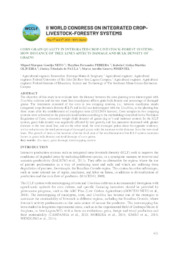Corn grain quality in integrated crop-livestock-forest systems: how distance of tree lines affects damage and bulk density of grains.
Corn grain quality in integrated crop-livestock-forest systems: how distance of tree lines affects damage and bulk density of grains.
Author(s): PIMENTEL, M. A. G.; GONTIJO NETO, M. M.; PEREIRA, T. F.; OLIVEIRA, I. C. M.; PAULA, J. T. de
Summary: The objective of this study is to evaluate how the distance between the corn planting rows intercropped with Urochloa cultivars and the tree stand line (eucalyptus) affects grain bulk density and percentage of damaged grains. The treatments consisted of the corn in two cropping systems, i.e., between eucalyptus stands (integrated crop-livestock-forestry-ICLF) and in full sun intercropped with the Urochloa, in the planting line three years after the establishment of eucalyptus trees (2013/2014 harvest). Corn samples in two cropping systems were submitted to the physical classification according to the methodology described in the Technical Regulation of Corn, volumetric weight (bulk density) of grains (kg m-3) and moisture content. In the ICLF system, grain bulk density was negatively affected by tree growth, and this parameter increased with greater distance to the tree stand line, and on the other hand, the total damaged grains show the opposite tendency, with a reduction in the total percentage of damaged grains with the increase in the distance from the tree stand lines. The growth of trees in the harvests after the third year of the establishment of the ICLF system increases losses in grain bulk density and total damage of corn grains.
Publication year: 2021
Types of publication: Paper in annals and proceedings
Unit: Embrapa Maize & Sorghum
Keywords: Milho, Pós-Colheita, Sistema consorciado
Observation
Some of Embrapa's publications are published as ePub files. To read them, use or download one of the following free software options to your computer or mobile device. Android: Google Play Books; IOS: iBooks; Windows and Linux: Calibre.
Access other publications
Access the Agricultural Research Database (BDPA) to consult Embrapa's full library collection and records.
Visit Embrapa Bookstore to purchase books and other publications sold by Embrapa.

